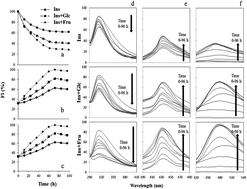Insulin glycation coupled with liposomal lipid peroxidation and microglial cell death†
Abstract
Type 2 diabetes is characterized jointly by hyperglycemia and hyperinsulinemia, which make insulin prone to glycation then fibrillation. It has been demonstrated that these processes result in production of free radicals. Insulin was incubated in the presence of glucose or fructose and the formation of related advance glycated end products (insulin-AGE) was monitored using spectrofluorimetric methods (including intrinsic, AGE dependent, 8-anilino-naphthalene sulfonic acid (ANS) binding and thioflavin T binding fluorescence) and circular dichroism (CD). Insulin glycation-induced liposomal membrane peroxidation was demonstrated by monitoring the formation of malondialdehyde (MDA). This product of insulin glycation activates glial cells and has an impact on their viability, causing microglial apoptosis, which was observed using MTT test and flow cytometry. The dramatic structural change of insulin due to glycation is a possible reason for insulin resistance. Receptor mediated microglial activation and apoptosis by insulin-AGE products and glycation-induced lipid peroxidation are proposed as contributing factors in neural cell death, causing the promotion of type 2 to 3 diabetes characterized by neurodegeneration and, more importantly, Alzheimer’s disease (AD).


 Please wait while we load your content...
Please wait while we load your content...